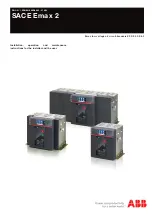
DET-653C
EntelliGuard
®
G Circuit Breaker Application Guide
24-May-12
Section 3. EntelliGuard TU Trip Unit System
©2012 General Electric All Rights Reserved
15
Table 3.4. Minimum Selective Clearing Times for an EntelliGuard G Circuit Breaker Above Selected GE Circuit Breakers,
and Related HRC Levels at Various Fault Circuits
GE Molded Case Circuit
Breaker Family
Circuit
Breaker
Type
Minimum
EntelliGuard TU
Short Time Band
Clearing
Time
480V, 32mm, 24in Working Distance,
Arc in a Box - HRC @ Ibf=
35kA 42kA 50kA 60kA 75kA 90kA 100kA
FB, FC, TEY, THQL
TM, LP
0.025sec
0.08sec
2
2
2
2
3
3
3
TED, TEC
TM-GP, MCP
0.025sec
0.08sec
2
2
2
2
3
3
3
TF, TJ, TK
TM-GP
0.025sec
0.08sec
2
2
2
2
3
3
3
Spectra E, F, G Frame
E-GP
0.025sec
0.08sec
2
2
2
2
3
3
3
Spectra K Frame
E-GP
0.033sec
0.088sec
2
2
2
2
3
3
3
Spectra G, K with MVT trip
AE-GP
0.025sec
0.08sec
2
2
2
2
3
3
3
Record Plus G Frame
E, AE-GP
0.042sec
0.097sec
2
2
2
2
3
3
3
Record Plus E Frame
E-GP
0.033sec
0.088sec
2
2
2
2
3
3
3
Power Break with MVT
AE-GP
0.058sec
0.113sec
2
2
2
3
3
3
3
Instantaneous Clearing Time
instantaneous
0.050sec
1
1
1
2
2
2
2
RELT Clearing Time
RELT Instantaneous
0.042sec
1
1
1
1
2
2
2
TM = Thermal Magnetic.
E = Electronic.
AE = Adjustable Electronic.
LP = Lighting Panel Application.
GP = General Purpose Application.
MCP = Motor Circuit Protector).
HRC = Hazard Risk Category (See NFPA 70E.
Above Other Power Circuit Breakers
Using the EntelliGuard TU trip unit’s unique Instantaneous
Zone Selective Interlocking (I-ZSI), the main circuit breaker
also can be set to interrupt selectively for faults in its zone
of protection. However, the pickup level must be nested to
prevent a nuisance trip at the main. Allowing for a 10%
tolerance in the pickup current of both trips, the upper
boundary of the main’s trip may be estimated at
approximately 11kA. Again, Figure 3.1 shows that
available fault currents above 25kA will generally produce
arcing currents above 11kA. Table 3.4 shows a system
with fault currents from 35kA to 100kA, the feeder and
main circuit breaker will provide protection at HRC1 or
HRC2 selectively above most circuit breakers using short
time bands. Coordinated instantaneous settings would
provide even better protection while still maintaining
selectivity with select feeder breakers. To this capability
one can add the RELT instantaneous setting that provides
more sensitive and faster protection when needed.
Terminology
In: Trip plug rating in amperes. This is the current rating of
the rating plug installed in the trip unit. This is the
maximum Long Time pickup a trip unit can have with a
specific plug installed. A sensor can usually be applied
with plugs between 37.5% or 40% to 100% of the sensor
rating. Plugs are labeled in amperes.
X: X is a multiplier that may be applied in front of any
rating value to denote a fraction of that rating. Example:
The Long Time Pickup may be set at 0.5X of In.
HSIOC: High Set Instantaneous Overcurrent, also known
as the Override. This is an Instantaneous protection
setting applied near the circuit breaker’s withstand rating
required to clear high magnitude faults quickly. In UL489
circuit breakers this is fixed; in UL1066 CBs the override
may vary, if present at all.
MCR: Making Current Release. A setting provided with
each trip unit, based on the specific circuit breaker size,
used to protect the circuit against closing on high
magnitude faults. The MCR function immediately
trips/opens the circuit breaker if high magnitude fault
current is sensed at the instant the circuit breaker is
closed.
ICW: Short Circuit Withstand Rating of a particular circuit
breaker in amperes. The withstand rating is defined
differently within different standards, but it is always the
value of current that a circuit breaker can withstand for
some period of time without interrupting.
ICU: Short Circuit Interrupting Rating (ISC), or ultimate
interrupting rating (ICU) in IEC terms. The maximum short-
circuit interrupting rating of a circuit breaker in amperes.
















































